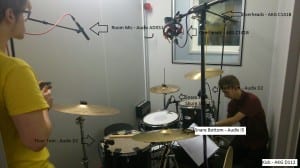The Bass guitar sometimes gets overlooked in a song but never the less its a vital part. It carries the rhythm and adds the low ends that guitars can’t. We used the dead room to record the Bass as it provides a dry recording allowing to mix more freely.We decided as a Group to use a Microphone on the Bass amplifier and a DI Box to record the Bass guitar. This is a pretty common way of recording a bass as the DI records a clean signal and the microphone picks up the bass features on the amplifier. We tested two microphones for the amp which were the AKG D112 and the AKG C414. The D112 is perfect for picking up low frequencies as it is used on Kick drums so it fits perfectly for a bass guitar. The 414 however has a broader frequency range so it could give the bass more colour. After a considerably amount of time we decided to go with the D112 as it had much more character and it boosted the rich frequencies of the bass amplifier.
Before we started recording we had one problem with the tuning of the bass guitar, none of had a proper bass tuner so had to resort to a mobile phone application. Problem with this is that it is not a accurate as a proper tuner.
There was one issue with the DI box as it made a fuzzy background noise but was simply over come by turning the “ground lift” switch on. The recording went really smoothly apart front one note at the end which was simply recorded over using the “pre roll” feature on pro tools which basically is an easier way to record over a recorded piece as it counts however many beats of the song before you start recording.
